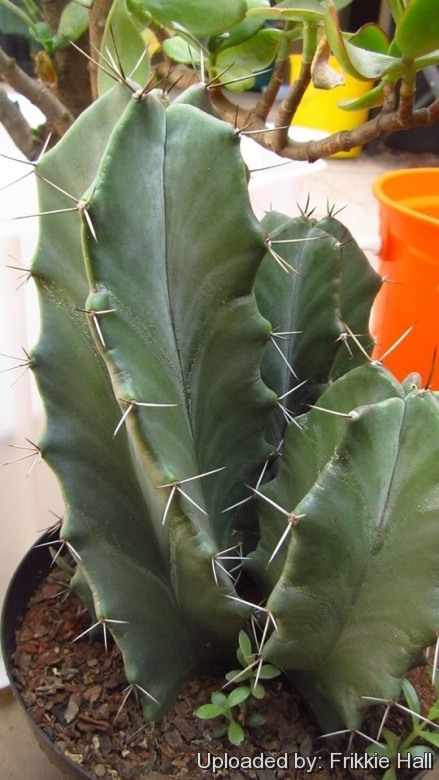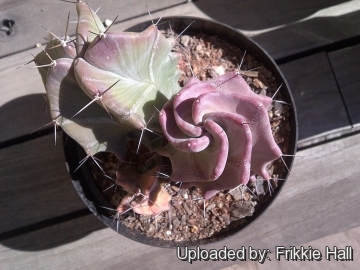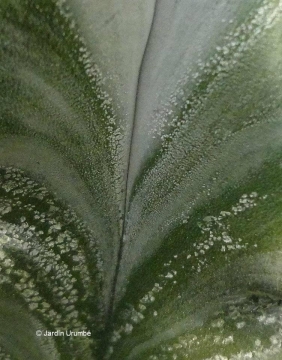Accepted Scientific Name: Stenocereus pruinosus (Otto) Buxb.
Bot. Stud. Heft 12 (Entwickl. Trib. Pachycereae) 101 (1961).

Cereus pruinosus (Stenocereus pruinosus) Photo by: Frikkie Hall
Origin and Habitat: Stenocereus pruinosusSN|7945]]SN|7951]] is widely distributed and very abundant in Mexico in the states of Oaxaca, Puebla and Veracruz (and also Guerrero and Chiapas ). The species is abundant and cultivated due to its edible fruit.
Altitude range It grows at elevations of 800 to 1,900 metres above sea level.
Habitat and Ecology: Stenocereus pruinosos is found in tropical deciduous forest in vegetation associations of Bursera morelensis and Escontria chiotillaSN|7764]]SN|7764]]. Other accompanying cactus species can be Mitrocereus fulviceps, Myrtillocactus eichlamii, Stenocereus stellatusSN|7951]]SN|7945]], Marginatocereus marginatusSN|8045]]SN|8045]], Nyctocereus chontalensis, Pilosocereus quadricentralisSN|6889]]SN|6889]] and Lemaireocereus hollianusSN|7440]]SN|7440]]. It is also found in secondary vegetation, in disturbed tropical deciduous forest, disturbed thorny scrub, and cultivated in orchards. There are no known threats to this species. The species is widely cultivated.
Synonyms:
See all synonyms of Stenocereus pruinosus
back
Accepted name in llifle Database:Stenocereus pruinosus (Otto) Buxb.Bot. Stud. Heft 12 (Entwickl. Trib. Pachycereae) 101 (1961).Synonymy: 11
back
Common Names include:
ENGLISH: Gray Ghost Organ Pipe, Pitayo, Pitaya of October
SPANISH (Español): Pitayo, Pitayo de Octubre, Pitaya, Pitayo de mayo, Cuapatla, Xoconostle
Description: Stenocereus pruinosusSN|7945]]SN|7951]] is a large shrubby or tree-like columnar cactus to 4-5(-7) m tall, usually with one or more, definite trunk(s) from which little-branching stems arise from the base for a distinctive V-shape. This plant is certainly native in south-central Mexico, and distinguishable from the related cultivated Stenocereus griseusSN|8205]]SN|7855]] by fewer ribs, larger flowers, and ovoid fruit. The pruinose colour of young branches distinguishes it from the other arborescent species. This cactus is also known as 'pitayo de Octubre' or 'pitayo de mayo' in Mexico, which indicates its ripens mainly around October and May.
Stems: 8-10(-12) cm in diameter, grey-green to dark green, the new growth often bearing a distinctive white-glaucous bloom near apex.
Ribs: 5-6 (rarely to 8 or even 10) very hight, separated by broad intervals and with wavy margins.
Areoles: Up to 3-4 cm apart. Flowering areoles large, brown-felted.
Central spines: 1-4, grey to brownish, 2-3 cm long.
Radial spines: 5-8, greyish to brownish, radiating, 1-2 cm long.
Flowers: Borne on new growth at the stem tips. Funnel-shaped, modestly sized up to 9 cm long, 7 cm wide and packed with yellow stamens. Upper scales and outer perianth-segments 1 cm long or less, rounded at apex. Inner perianth-segments white or pinkish longer and thinner than the outer ones. Ovary with numerous brown-felted areoles.
Fruit: Ovoid the size of a small apple, 5-8 long, varying from yellow, orange-green to purple, without persistent perianth parts. The outer skin of the fruit is spiny in youth, growing smooth with maturity making them easier to harvest.
Phenology (in habitat): Flowers open in from late February to May and later in September as around the clock bloomers to exploit both day and night flying pollinators and produces fruits between May and October.
Seeds: 2-2.5 mm, black, warty.
Taxonomic Notes: Hunt et al. (2006) consider Stenocereus laevigatusSN|7855]]SN|8205]] (Salm-Dyck) Buxb. as part of S. pruinosus, however, Arreola (2006) reports it as valid species. Natural hybrids may be possible with Stenocereus stellatusSN|7951]]SN|7945]].
Subspecies, varieties, forms and cultivars of plants belonging to the Stenocereus pruinosus group
 Stenocereus pruinosus (Otto) Buxb.: is a large shrubby or tree-like columnar cactus to 4-5(-7) m tall, with one or more, trunks from which little-branching pruinose stems arise. Distribution: Mexico in the states of Oaxaca, Puebla, Veracruz, Guerrero and Chiapas.
Stenocereus pruinosus (Otto) Buxb.: is a large shrubby or tree-like columnar cactus to 4-5(-7) m tall, with one or more, trunks from which little-branching pruinose stems arise. Distribution: Mexico in the states of Oaxaca, Puebla, Veracruz, Guerrero and Chiapas. Stenocereus pruinosus f. variegata hort.: variegated form with sectors, patches or stripes with two colours, yellow and grey-green. There are several forms of variegation.
Stenocereus pruinosus f. variegata hort.: variegated form with sectors, patches or stripes with two colours, yellow and grey-green. There are several forms of variegation.
Bibliography: Major references and further lectures
1) Britton & Rose "The Cactaceae" volume 2, 1920
2) Edward Anderson “The Cactus family” Timber Press, Incorporated, 2001
3) James Cullen, Sabina G. Knees, H. Suzanne Cubey "The European Garden Flora Flowering Plants: A Manual for the Identification of Plants Cultivated in Europe, Both Out-of-Doors and Under Glass" Cambridge University Press, 11/Aug/2011
4) David R Hunt; Nigel P Taylor; Graham Charles; International Cactaceae Systematics Group. "The New Cactus Lexicon" dh books, 2006
5) Hecht. “BLV Handbuch der Kakteen” 287(1982) - as Polaskia chichipe.
6) Arreola, H. 2013. Stenocereus pruinosus. The IUCN Red List of Threatened Species. Version 2015.2. <www.iucnredlist.org>. Downloaded on 26 July 2015.
7) William H. Beezley “A Companion to Mexican History and Culture” John Wiley & Sons, 16 March 2011
 Young speciemens. (Stenocereus pruinosus) Photo by: Frikkie Hall
Young speciemens. (Stenocereus pruinosus) Photo by: Frikkie Hall Cereus pruinosus (Stenocereus pruinosus) Photo by: Alexander Arzberger
Cereus pruinosus (Stenocereus pruinosus) Photo by: Alexander ArzbergerCultivation and Propagation: Stenocereus pruinosusSN|7855]]SN|7951]] is large columnar cactus is a valuable food source in Mexico where its fruit is harvested and sold in some rural markets. This is an easy to grow cactus but not cold hardy. It is a popular potted plant indoors and out provided the potting soil is sufficiently porous and well drained. .
Growth rate: It produces good amounts of growth each year if kept well fed and watered throughout the warmest months, particularly if it has been acclimatised to accept full sun. It will make clumps given the best conditions.
Soils: It likes very porous fertile cactus mix soil.
Repotting: Use pot with good drainage.
Watering: Water regularly in summer, but do not overwater (Rot prone), keep dry in winter.
Fertilization: Feed with a high potassium fertilizer in summer.
Hardiness: Reputedly sensitive to frost , but less so if kept on the dry side prior to, and during, cold weather (hardy to -0° C for short periods). However warmth throughout the year will increase the grower's success (8-12°C during rest season). During winter month, put them in a cool luminous place and encourage them to enter winter dormancy by withholding water and fertiliser over the winter as they will etiolate, or become thin, due to lower levels of light.
Exposition: Outside full sun, inside need bright light, and some direct sun. Tends to produce a dense white bloom in strong light, which encourages also flowering and spine production.
Garden uses: It is an excellent plant for container growing. It always looks good and stays relatively small. It look fine in a warm greenhouse and frame or outdoor in a rockery. It is commonly cultivated for living fences in tropical and subtropical America (especially in Mexico).
Uses: Stenocereus pruinosusSN|7951]]SN|7951]] has several uses: edible fruits, fodder, live fences, and wood.
Thousands of these plants, are grow in intensely managed orchards in Oaxaca and elsewhere in mexico, but in many places the harvest of fruit is from wild populations. This harvest does not affect wild populations. The fruits have been of great importance to Native Americans of the Sonoran Desert. The baseballsized fruits of unmatched sweetness rippens in late spring and early autumn.
Pests & diseases: It may be attractive to a variety of insects, but plants in good condition should be nearly pest-free, particularly if they are grown in a mineral potting-mix, with good exposure and ventilation. Nonetheless, there are several pests to watch for:
- Red spiders: Red spiders may be effectively rubbed up by watering the plants from above.
- Mealy bugs: Mealy bugs occasionally develop aerial into the new growth among the wool with disfiguring results, but the worst types develop underground on the roots and are invisible except by their effects.
- Scales: Scales are rarely a problem.
- Rot: They are susceptible to fungal diseases if overwatered, but are not nearly as sensitive as many other cacti, especially in warm weather. If kept damp through cold periods, they will invariably suffer. However rot is only a minor problem with cacti if the plants are watered and “aired” correctly. If they are not, fungicides won't help all that much.
Propagation: Division, direct sow after last frost. The seeds of Stenocereus griseusSN|7951]]SN|7855]] are quite easy to germinate and grow and maintain their viability alter 12 months of storage, reaching germination percentages of 90 to 100% four days alter sowing. Germination is inhibited as long as the seeds are embedded in the pulp but is high for cleaned seed. The seeds require light and germination is somewhat enhanced at hight temperature (35°C and 40°C) and depressed at 20°C. Remove the glass cover gradually as the plants develops and keep ventilated, no full sun for young plants! To make a cutting twist off a branch and permit it to dry out a couple of weeks, lay it on the soil and insert the stem end partially into the soil. Try to keep the cutting somewhat upright so that the roots are able to grow downward.













